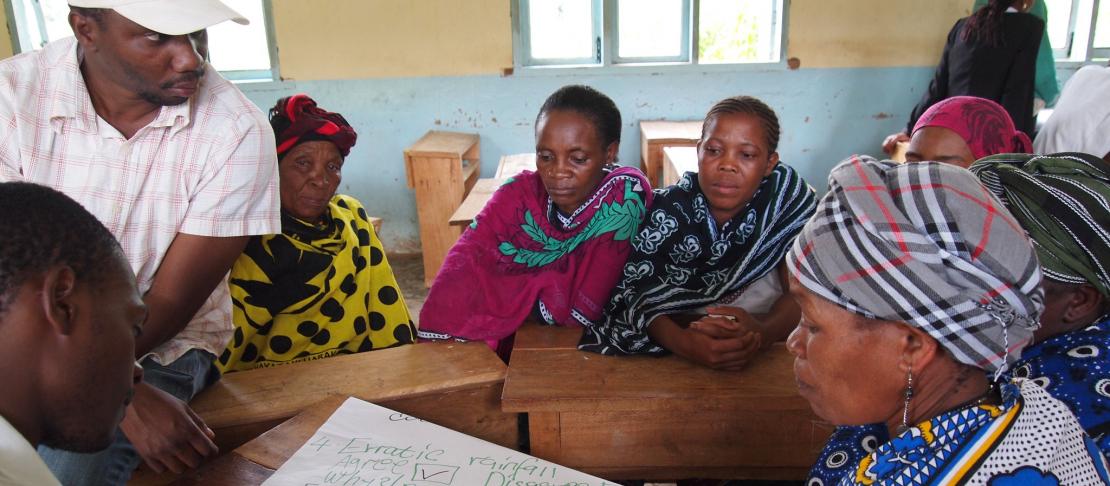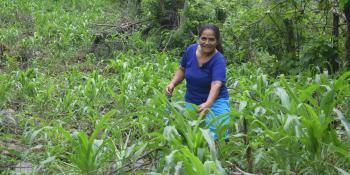East Africa reached by participatory action research activities

by Anton Eitzinger (CIAT)
During the month of November last year, several researchers from the International Center for Tropical Agriculture (CIAT) implemented participatory action research in four of the CCAFS East Africa sites. The participatory research was part of a multi-disciplinary project that aims to combine data on inherent soil properties, as well as ecological and land degradation status of the sites (see Land Degradation Surveillance Framework LDSF) into the development of robust crop suitability and prediction models. Socio-economic data including gender disaggregated data collected from the CCAFS household baseline survey (get data here), supplemented by a questionnaire survey carried out through local partners, will be analyzed to better understand the constraints and opportunities for adaptation.
The outcomes of the project will be: (1) improved understanding of the suitability for beans, cassava and forages in East Africa under projected climate change scenarios based on up-to-date biophysical environmental survey data; (2) availability of decision tools to scientists for germplasm collection, evaluation and trait transfer (response of different varieties under specific management practices to climate change examined); (3) improved understanding by farmers about long-term options for crop adaptation to changing climatic conditions, and (4) improved knowledge of the constraints and challenges faced by farmers †for transformative adaptation. CIAT's mandate crops, Beans, Tropical Forages and Cassava, are the first or second most important crops in the East Africa sites and represent a range of response options for farmers and for research initiatives.
To develop improved crop suitability models under various climate change scenarios, a close collaboration with the agro-biodiversity area at CIAT is a key component of the on-going project. To deliver an end-to-end analysis, the missing information about site-specific agronomic management was collected during the field work and modeling parameters will be reconciled in the following month to improve model outputs.
In order to deliver appropriate climate change adaptation and mitigation strategies, stimulating the feedback-loop between farmers and researchers is crucial. Therefore, transect walks and participatory workshops were held during the fieldwork together with farmer and local experts from agricultural institutions.
A decisive task of the project is also to link activities from previous CCAFS work and coordinate with researchers of other on-going projects. The fieldwork team met scientists from World Agroforestry Centre (ICRAF), International Livestock Research Institute (ILRI) and International Institute of Tropical Agriculture (IITA) during their stay to interchange experiences and find overlaps where they can complement each other in their work. The next project steps after analyzing the obtained data will be an Expert Data Analysis Workshop for CCAFS Site Projects in Nairobi, Kenya and a Partner Data Analysis Workshop and Adaptation Strategy Development in Arusha, Tanzania.
The site visits
The lower and upper regions of the CCAFS Nyando site are located in western Kenya near Lake Victoria. This site is comprised of two tribes and two main agro-ecological regions. The Luo, traditionally a fishing tribe, live in lower Nyando, which is characterized by soil erosion and lower agricultural production. The Kalenjin live in upper Nyando and have more rainfall and higher productivity. View photos from the transect walk in the lower and upper regions of the CCAFS Nyando site:
The Hoima site is located in western Uganda near Lake Albert. The site is a productive region and diverse in crop production. We counted more than 30 crops in the workshop and identified many changed practices during recent years to improve production. However, during the workshop, farmers reported that rainfall has been erratic and that land is less productive.
Photos from transect walk and farmer workshop in Hoima:
Yabelo Ethiopia. This region, formerly mainly grassland and pastoral area, is relatively young in terms of crop production. Farmers reported that invading bushes and trees narrow down possibilities to increase crop cultivating activities. Extended drought periods also force them to introduce different feeding and fodder management strategies for their livestock. These strategies include cut & carry and preserving grazing areas through protection/fencing as well as hay production. Introduction of crop production has also resulted in a change in tenure system from what was dominantly communal land ownership to privatization.
Transect walk and workshop with Borana farmers:
Lushoto, in the West Usambara Mountains in Tanzania. This area is marked by a high population density and limited areas for production, a landscape with steep slopes, various water sources and native forest fragments. There are also a variety of land uses, including: intensive smallholder vegetable production; smallholder maize, beans and cassava production. As a consequence of increased population pressure on land, extensive farming through clearance of bushes and forests has been common. However, farmers and partners in the site indicated that the government has put up legislative measures to curb deforestation. An important finding of the workshop was that men are mostly associated with cash crops while women are associated with crops for home consumption. The research team also found that cassava is an important crop for food security but poor in technical development (it takes up to 3 years).
Transect walk and farmer-workshop in Lushoto, Tanzania:
This blog story was written by Anton Eitzinger, based at the International Center for Tropical Agriculture (CIAT) in Colombia. The story was originally published on the Decision and Policy Analysis blog (DAPA). Learn more about our activities in East Africa by following Cgiarclimate East Africa on Twitter.


